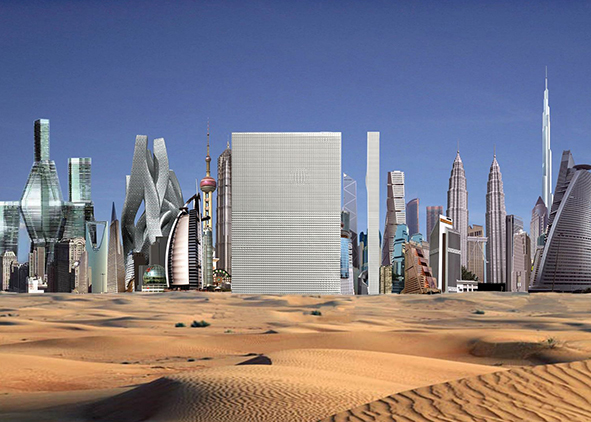Dubai transient city. Anatomia di un fenomeno post-urbano
DOI:
https://doi.org/10.19229/2464-9309/682019Parole chiave:
Dubai, frammentazione, dispersione urbana, distopia, transitorioAbstract
Nell’immaginario collettivo, Dubai è un’affascinante e dinamica giovane metropoli proiettata nel futuro. Diverse proposte urbanistiche hanno tentato di governare la sua rapida espansione, accelerata dalla scoperta del petrolio nel 1966. John Harris, George Candilis, lo studio milanese BBPR, Reima Pietilä e in tempi più recenti Norman Foster, OMA e altri hanno negli anni presentato proposte spesso velocemente superate dal suo inarrestabile sviluppo urbanistico. Oggi, le luci cangianti dello skyline di questo agglomerato urbano sorto improvvisamente dal deserto comunicano l’immagine audace di una città in cui fiction e realtà spesso si confondono. Ma cosa si nasconde dietro le scene di questo straordinario spettacolo urbano? La sua rapidissima e incontenibile crescita ha comportato diffusi fenomeni di urban sprawl e la proliferazione di junkspaces. Zone ad alta densità si alternano ad ampie aree inedificate e desertiche, in un paesaggio urbano frammentato che genera in molti expat europei un diffuso senso di straniamento ‘perturbante’. In una città Non-Città, dove centri commerciali e hotel diventano i principali centri di aggregazione sociale, la struttura urbana somiglia sempre più a una dis-connessione di Non-Luoghi, elevati al rango di landmark urbani. Saprà Dubai mostrare capacità di resilienza e rigenerazione urbana di fronte alle attuali veloci e imprevedibili trasformazioni degli equilibri economici e geopolitici nella regione del Golfo? L’obiettivo di questo saggio è di individuare le dinamiche che hanno determinato lo scenario distopico dell’attuale paesaggio urbano di Dubai, proponendo possibili soluzioni per mitigare l’impatto delle contraddizioni esistenti.
Downloads
##plugins.generic.articleMetricsGraph.articlePageHeading##
Riferimenti bibliografici
Aglieri Rinella, T. (2019), “Dubai, 1974. Reima and Raili Pietilä’s project for the Deira Sea Corniche Competition”, in Ananke, n. 86, pp. 119-123.
Aglieri Rinella, T. (2016), “Learning from Dubai – Behind an urban show”, in Migration and the Built Environment in the Mediterranean and Middle East ̧ International Symposium, Naples, November 24-25th 2016, Ermes Servizi Editoriali Integrati srl, DIARC Università degli Studi di Napoli ‘Federico II’, pp. 207-215.
Aglieri Rinella, T. and Garcia Rubio, R. (2019), Dubai Pop-Up. Architecture in a Transient City, Maggioli Editore, Santarcangelo di Romagna (RN).
Aglieri Rinella, T. and Garcia Rubio, R. (2018), “John Harris and Dubai. Political insights, urban planning and architectural landmarks”, in Tostões, A. and Koselj, N. (eds), Metamorphosis – The Continuity of Change – Conference proceedings of 15th International DOCOMOMO Conference, Ljubljana, Slovenia, 28-31 August, Docomomo Slovenia, pp. 511-517. [Online] Available at: docomomo2018.si/index.php/15idc-conference-proceedings [Accessed 12 September 2019].
Airvisual (2019), World Air Quality Ranking. [Online] Available at: www.airvisual.com/world-air-quality-ranking [Accessed 3 October 2019].
Augé, M. (1995), Non-Places – Introduction to an Anthropology of Supermodernity, Verso, London-New York.
Baldwin, E. (2019), Machou Designs World’s Longest Urban Agriculture Park for Dubai. [Online] Available at: www.archdaily.com/917443/machou-designs-worlds-longest-urban-agriculture-park-for-dubai/ [Accessed 18 November 2019].
Benjamin, W. (1962), Angelus novus, Einaudi, Torino.
DSC – Dubai Statistic Center (2019), Population clock. [Online] Available at: www.dsc.gov.ae/en-us/EServices/Pages/Population-Clock.aspx [Accessed 26 July 2019].
Elsheshtawy, Y. (2010), Dubai – Behind an Urban Spectacle, Routledge, London-New York.
Garcia Rubio, R. and Aglieri Rinella, T. (2017), “Impulsos urbanos. Apuntes para entender el presente y el futuro de Dubai | Urban impulses. Notes to understand the present and the future of Dubai”, in Zarch | Journal of interdisciplinary studies in Architecture and Urbanism, vol. 8, pp. 79-89. [Online] Available at: doi.org/10.26754/ojs_zarch/zarch.201782147 [Accessed 18 July 2019].
Kayden, J. S. (2000), Privately Owned Public Space – The New York City Experience, John Wiley & Sons.
Luchetti, C. (2019), “Dubai walk-in city”, in Ananke, n. 86, pp. 124-128.
Morris, A. E. J. (1984), John R. Harris Architects, Hurtwood Press, Westerham, Kent.
Reisz, T. (2015), “Future Flyovers: Dubai in 1971”, in Architectural Design, vol. 85, issue 1, pp. 100-105. [Online] Available at: doi.org/10.1002/ad.1859 [Accessed 18 July 2019].
Velegrinis, S., Katodrytis, G. (2015), “Drawing on sand. Cities in the making”, in Architectural Design, vol. 85, issue 1, pp. 72-79. [Online] Available at: doi.org/10.1002/ad.1856 Accessed 6 September 2019].
Venturi, R., Scott Brown, D. and Izenour, S. (1972), Learning from Las Vegas – The forgotten symbolism of architectural form, The MIT Press, Cambridge-London.
Vidler, A. (1992), The Architectural Uncanny – Essays in the Modern Unhomely, The MIT Press, Cambridge-London.

##submission.downloads##
Pubblicato
Come citare
Fascicolo
Sezione
Licenza
AGATHÓN è pubblicata sotto la licenza Creative Commons Attribution License 4.0 (CC-BY).
License scheme | Legal code
Questa licenza consente a chiunque di:
Condividere: riprodurre, distribuire, comunicare al pubblico, esporre in pubblico, rappresentare, eseguire e recitare questo materiale con qualsiasi mezzo e formato.
Modificare: remixare, trasformare il materiale e basarti su di esso per le tue opere per qualsiasi fine, anche commerciale.
Alle seguenti condizioni
Attribuzione: si deve riconoscere una menzione di paternità adeguata, fornire un link alla licenza e indicare se sono state effettuate delle modifiche; si può fare ciò in qualsiasi maniera ragionevole possibile, ma non con modalità tali da suggerire che il licenziante avalli l'utilizzatore o l'utilizzo del suo materiale.
Divieto di restrizioni aggiuntive: non si possono applicare termini legali o misure tecnologiche che impongano ad altri soggetti dei vincoli giuridici su quanto la licenza consente di fare.
Note
Non si è tenuti a rispettare i termini della licenza per quelle componenti del materiale che siano in pubblico dominio o nei casi in cui il nuovo utilizzo sia consentito da una eccezione o limitazione prevista dalla legge.
Non sono fornite garanzie. La licenza può non conferire tutte le autorizzazioni necessarie per l'utilizzo che ci si prefigge. Ad esempio, diritti di terzi come i diritti all'immagine, alla riservatezza e i diritti morali potrebbero restringere gli usi del materiale.


















































































